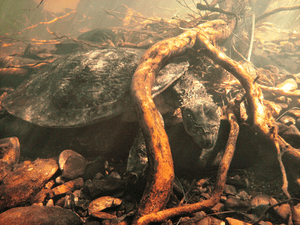Fitzroy River turtle facts for kids
Quick facts for kids Fitzroy River turtle |
|
|---|---|
 |
|
| Conservation status | |
| Scientific classification | |
| Genus: |
Rheodytes
|
| Species: |
leukops
|
| Synonyms | |
|
|
The Fitzroy River turtle (Rheodytes leukops) is a species of freshwater turtle. It is the only surviving member of the genus Rheodytes. The species is endemic to south eastern Queensland, Australia. Their habitat comprises a total area of less than 10,000 km2, including the Fitzroy, Mackenzie and Dawson rivers.
Contents
Description
The Fitzroy River turtle is light to dark brown in color. They grow to approximately 260 mm in carapace length. The shells of hatchlings (up to 95 mm long) are highly serrated while adults have rounded, smooth-edged shells. The upper surfaces of their necks are scattered with blunt to pointed conical skin tubercle. The species has a single pair of barbels on the lower jaw. The Fitzroy River turtle is capable of obtaining up to 70% of its oxygen needs from the water through its cloaca. Due to this, the Fitzroy River turtle can remain underwater for up to three weeks.
Biology
Diet
This turtle is a bottom feeder. They prey on terrestrial and aquatic insects, macroinvertebrates, crustaceans, algae, aquatic snails, worms, freshwater sponges and aquatic plants.
Natural history and observations in the wild
This species shows a preference for fast flowing water (near sand banks for egg laying) and has been found at depths as shallow as 15 cm. In most encounters, they have been found lying still, hidden by overhanging plant foliage along the shallow banks of fast flowing riffles (fast flowing streams or rapids) and under logs.
Breeding biology
The tail of the female is shorter than that of the male. The most accurate way to differentiate between sexes is to compare the distance between the anal scutes of the plastron and the cloacae. In males, the cloacae is located further away from the plastron than in females. Most other short-necked turtles in Australia show obvious differences in tail length and thickness.
Conservation status
The species has been listed as vulnerable since 1994 under both the Environment Protection and Biodiversity Conservation Act (EPBC Act 1999) and the Queensland Nature Conservation Act, 1992. The main threats to the Fitzroy River turtle are:
- reduction in levels of oxygen in water;
- reduction in the number of prey;
- a shift from fluvial (having fast flowing water) to lacustrine (related to lakes) habitat;
- the increasing amount of sand and mud on the river floor impacts their cloacal breathing mode


